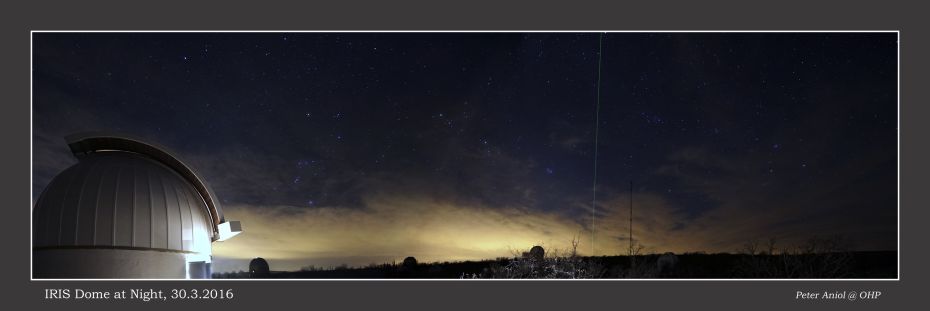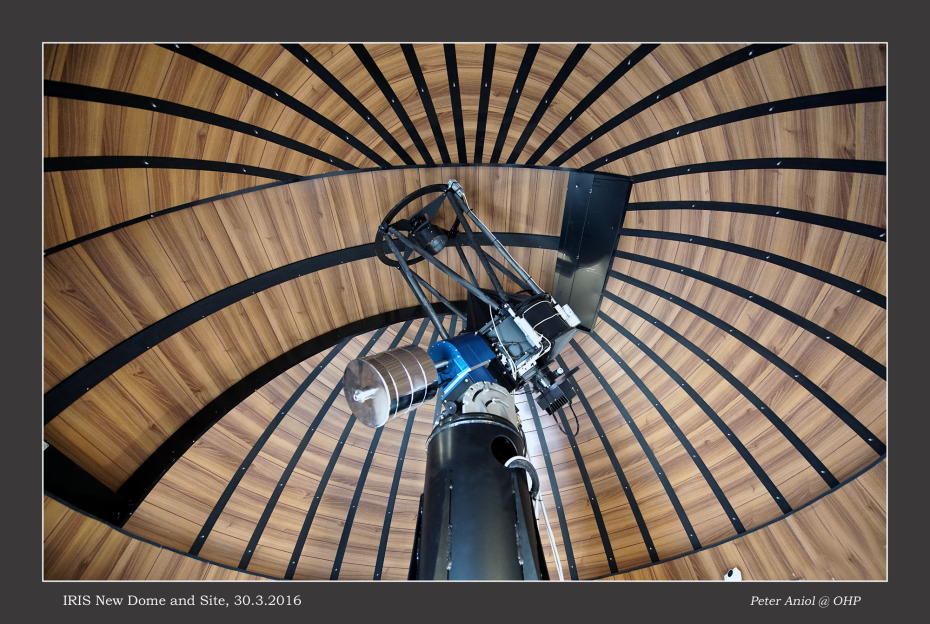Motivation of the IRiS project
In order to allow the discovery of the sky by the youngest, while offering the possibility to discover modern observational technics, OCEVU installed in 2013, and operates since then, a robotic telescope on the site of the Observatoire de Haute de Provence. This program has been named IRiS for Initiation to Research in Astronomy for Schoolchildren.
The idea behind this program is very simple: to offer students, from junior high school to Master's level, privileged access to a telescope whose operating mode and technical features, apart from its diameter, are in every way similar to the telescopes currently used by professional astronomers.
The telescope is of the Ritchey-Christian type with a diameter of 50 cm mounted on a German type mount and equipped with a focal plane composed of a camera equipped with an E2V 42-40 (2kx2k) sensor, a filter wheel and filters (SDSS u, g, r, i, z, as well as the narrow bands centered on the H-alpha and OIII lines).
The whole telescope and its equipment is fully remotely controllable from a web interface. It also gives access to all environmental data related to the observatory (AllSky camera, weather station, seeing monitor, etc.). Users have a very high degree of flexibility in configuring the telescope and its instrumentation. Only operations that could endanger the integrity of the system are strictly forbidden (errors are not automatically corrected for educational purposes). A simulator of the telescope and its instrumentation is also available.
Pedagogical motivation
Astronomy allows a stimulating approach to many aspects of the scientific process with students, whether on disciplinary or cross-curricular aspects.
IRiS, by offering a professional observation environment, thus offers complementary opportunities to the usual astronomy pedagogical workshops. The time devoted to the setting up of the equipment and its implementation is almost non-existent here and once the interface is mastered, time can be entirely devoted to the choice of targets, the analysis of images and the scientific and pedagogical exploitation of the observations. The professional performances of the telescope also offer a very wide range of types of projects that can be carried out by teachers, from activities related to the discovery of the sky through the production of astronomical images of very good quality, to projects with a real scientific objective (monitoring of exoplanets and supernovae for example).
The pedagogical motivation of an IRiS project led by a teacher in a classroom are typically the following:
- Acquisition of scientific and technical knowledge: discovery of the sky, distribution of matter in the Universe, habitability and exoplanets, nature of the light, physics of the atmosphere, optics, detectors, etc.
- Practice of the scientific approach: definition of the subject, documentary research, definition of the targets, interpretation of results, communication.
- Construction and follow-up of a project: management of a schedule, organization, documentation.
- Mastery of digital tools: documentary research, preparation of observations, telescope piloting, data processing, communication.
- Carrying out scientific studies at a "professional" level: observation and identification of artificial satellites, observation of variable stars, calculation of asteroid trajectories, observation of exoplanets, discovery and characterization of supernovae, etc.
- Decision-making and accountability: taking into account changing conditions and adapting the observation strategy to avoid endangering the equipment.
Partners
- Labex OCEVU and now IPhU (project management).
- Labex FOCUS.
- Laboratoire d'Astrophysique de Marseille.
- Observatoire de Haute-Provence - OSU-Pytheas.
- Observatoire de Paris.
- Science à l’Ecole.
- Région Académique Provence-Alpes-Côte-d'Azur.
Contacts
- Site IRiS.
- Email: iris-contact at lam.fr



